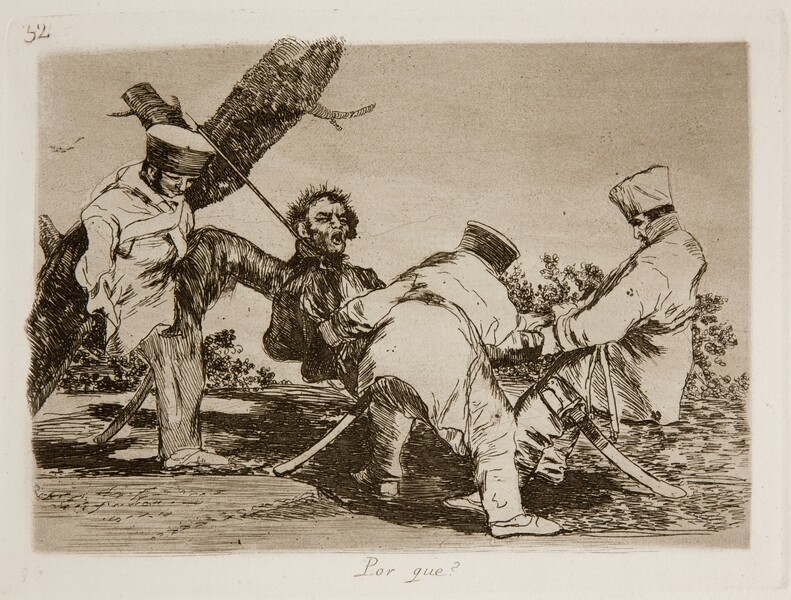- Cronología
- Ca. 1812 - 1815
- Dimensiones
- 157 x 209 mm
- Técnica y soporte
- Aguafuerte, aguatinta, lavis, punta seca y bruñidor
- Reconocimiento de la autoría de Goya
- Undisputed work
- Ficha: realización/revisión
- 08 Dec 2010 / 07 Nov 2024
- Inventario
- 225
49 (on the lower left-hand corner).
See Sad presentiments of what must come to pass (Tristes presentimientos de lo que ha de acontecer).
The title was handwritten on the print by Goya in the first and only series that is known to have been printed at the time the works were created, which the artist gave to his friend Agustín Ceán Bermúdez. Therefore, the title was etched into the plate at a later date and left unchanged as of the first edition of the Disasters of War printed by the San Fernando Royal Academy of Fine Arts in Madrid in 1863, after the printing of the series in the possession of Ceán Bermúdez.
There are no surviving preparatory drawings for this print.
In the middle of a natural setting a man is being subjected to brutal torture. Two French soldiers are holding the legs of a Spanish man they have taken prisoner whose head has been tied to a tree with a rope. The rope is taught, squeezing tight around the neck of the prisoner. His eyes are closed, his mouth open. The figure seems to be screaming in pain, his hair standing on end from the unbearable physical suffering. One soldier pushes his foot into the prisoner's back to ensure that the rope is tight enough to asphyxiate him.
This image continues the theme represented in the previous print, no. 31, That's tough! (Fuerte cosa es), in which a solider pulls on the feet of a hanged man to hasten his death or make sure that he is already dead. The two scenes are equally cruel, depicting torture meted out without pity.
The title of this print poses a question, Why?, asking what is the sense or reason behind such a level of suffering. The question is carried over into the next print, no. 33, What more can be done? (Qué hai que hacer mas?). Goya reiterates his inability to understand the events he depicts, answering his own question in print no. 35 in which he admits that One can't tell why (No se puede saber por qué).
Nature is complicit in this torture: the trunk of the tree, which has a burned, dry appearance, provides a support for this atrocious act of violence.
The plate is stored in the National Chalcography (cat. 283).
-
Goya. Drawings, Etchings and LithographsGoya. DrawingsLondon1954from June 12th to July 25th 1954cat. 55
-
De grafiek van GoyaRijksmuseum RijksprentenkabinetAmsterdam1970from November 13th 1970 to January 17th 1971cat. 74
-
Francisco de GoyaMuseo d'Arte ModernaLugano1996exhibition celebrated from September 22nd to November 17th.cat. 32
-
Francisco Goya. Sein leben im spiegel der graphik. Fuendetodos 1746-1828 Bordeaux. 1746-1996Galerie KornfeldBern1996from November 21st 1996 to January 1997cat. 118
-
Francisco Goya. Capricci, follie e disastri della guerraSan Donato Milanese2000Opere grafiche della Fondazione Antonio Mazzottacat. 112
-
Goya. Opera graficaPinacoteca del Castello di San GiorgioLegnano2006exhibition celebrated from December 16th 2006 to April 1st 2007p. 67
-
Goya et la modernitéPinacothèque de ParisParís2013from October 11st 2013 to March 16th 2014cat.71
-
Goya: Order and disorderMuseum of Fine ArtsBoston2014cat. 198
-
Goya, grabadorMadridBlass S.A.1918cat. 134
-
Goya engravings and lithographs, vol. I y II.OxfordBruno Cassirer1964cat. 152
-
Vie et ouvre de Francisco de GoyaParísOffice du livre1970cat. 1047
-
Catálogo de las estampas de Goya en la Biblioteca NacionalMadridMinisterio de Educación y Cultura, Biblioteca Nacional1996cat. 236
-
ParísPinacoteca de París2013p. 135
-
Goya: Order & DisorderBostonMuseum of Fine Arts Boston Publications2014p. 292
-
Goya. In the Norton Simon MuseumPasadenaNorton Simon Museum2016pp. 114-151
